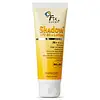What's inside
What's inside
 Key Ingredients
Key Ingredients

 Benefits
Benefits

 Concerns
Concerns

 Ingredients Side-by-side
Ingredients Side-by-side

Water
Skin ConditioningIsononyl Isononanoate
EmollientZinc Oxide
Cosmetic ColorantTitanium Dioxide
Cosmetic ColorantSilica
AbrasiveDicaprylyl Carbonate
EmollientCyclopentasiloxane
EmollientDimethicone Crosspolymer
Emulsion StabilisingCeramide NP
Skin ConditioningCeramide AP
Skin ConditioningCeramide EOP
Skin ConditioningPhytosphingosine
Skin ConditioningTocopheryl Acetate
AntioxidantPropanediol
SolventSqualane
EmollientC14-22 Alcohols
Emulsion StabilisingC12-20 Alkyl Glucoside
EmulsifyingEmulsifying Wax Nf
Polyacrylate Crosspolymer-6
Emulsion StabilisingNiacinamide
SmoothingXanthan Gum
EmulsifyingPhenoxyethanol
PreservativeEthylhexylglycerin
Skin ConditioningWater, Isononyl Isononanoate, Zinc Oxide, Titanium Dioxide, Silica, Dicaprylyl Carbonate, Cyclopentasiloxane, Dimethicone Crosspolymer, Ceramide NP, Ceramide AP, Ceramide EOP, Phytosphingosine, Tocopheryl Acetate, Propanediol, Squalane, C14-22 Alcohols, C12-20 Alkyl Glucoside, Emulsifying Wax Nf, Polyacrylate Crosspolymer-6, Niacinamide, Xanthan Gum, Phenoxyethanol, Ethylhexylglycerin
Water
Skin ConditioningEthylhexyl Methoxycinnamate
UV AbsorberOctocrylene
UV AbsorberEthylhexyl Salicylate
UV AbsorberBenzophenone-3
UV AbsorberButyl Methoxydibenzoylmethane
UV AbsorberPhospholipids
Skin ConditioningButylene Glycol
HumectantTitanium Dioxide
Cosmetic ColorantButylene Glycol Cocoate
EmulsifyingSteareth-2
EmulsifyingMyristyl Myristate
EmollientTocopheryl Acetate
AntioxidantSilica
AbrasivePhenoxyethanol
PreservativeEthylhexylglycerin
Skin ConditioningPolyisobutene
Polysorbate 20
EmulsifyingPolyacrylate-1 Crosspolymer
BHT
AntioxidantDiethylhexyl Syringylidenemalonate
Skin ProtectingDisodium EDTA
Water, Ethylhexyl Methoxycinnamate, Octocrylene, Ethylhexyl Salicylate, Benzophenone-3, Butyl Methoxydibenzoylmethane, Phospholipids, Butylene Glycol, Titanium Dioxide, Butylene Glycol Cocoate, Steareth-2, Myristyl Myristate, Tocopheryl Acetate, Silica, Phenoxyethanol, Ethylhexylglycerin, Polyisobutene, Polysorbate 20, Polyacrylate-1 Crosspolymer, BHT, Diethylhexyl Syringylidenemalonate, Disodium EDTA
 Reviews
Reviews

Ingredients Explained
These ingredients are found in both products.
Ingredients higher up in an ingredient list are typically present in a larger amount.
Ethylhexylglycerin (we can't pronounce this either) is commonly used as a preservative and skin softener. It is derived from glyceryl.
You might see Ethylhexylglycerin often paired with other preservatives such as phenoxyethanol. Ethylhexylglycerin has been found to increase the effectiveness of these other preservatives.
Phenoxyethanol is a preservative that has germicide, antimicrobial, and aromatic properties. Studies show that phenoxyethanol can prevent microbial growth. By itself, it has a scent that is similar to that of a rose.
It's often used in formulations along with Caprylyl Glycol to preserve the shelf life of products.
Silica, also known as silicon dioxide, is a naturally occurring mineral. It is used as a fine, spherical, and porous powder in cosmetics.
Though it has exfoliant properties, the function of silica varies depending on the product.
The unique structure of silica enhances the spreadability and adds smoothness, making it a great texture enhancer.
It is also used as an active carrier, emulsifier, and mattifier due to its ability to absorb excess oil.
In some products, tiny microneedles called spicules are made from silica or hydrolyzed sponge. When you rub them in, they lightly polish away dead skin layers and enhance the penetration of active ingredients.
Learn more about SilicaTitanium dioxide is a mineral UV filter widely used in sunscreens and cosmetics.
It is one of only two UV filters officially classified as “mineral” by regulatory agencies, the other being zinc oxide.
Titanium dioxide provides broad-spectrum protection mostly in the UVB and UVAII range, with some protection in the UVAI range.
While its UVA protection isn’t as strong as zinc oxide’s, the difference is minor.
A common myth is that mineral UV filters reflect UV light. However, modern research shows titanium dioxide absorbs UV radiation like chemical filters (~95% absorption & 5% reflection).
Thanks to its non-irritating nature, titanium dioxide is suitable for sensitive, acne-prone, or redness-prone skin. It is unlikely to cause "eye sting" like other sunscreen ingredients.
A major drawback of this ingredient is its white cast and thick texture. This is why mineral sunscreens often leave a white cast and are less cosmetically elegant than chemical/hybrid sunscreens.
To improve white cast and spreadability, micronized or nano-sized titanium dioxide is often used.
There are ongoing concerns surrounding nano-titanium oxide's impact on marine ecosystems.
There is no conclusive evidence that any form of titanium oxide (or any other sunscreen ingredients) will cause harm to marine ecosystems or coral reefs. The science is still developing but many consumers are keeping a close eye on this issue.
Please note, many destinations have reef-safety sunscreen rules. For instance, the U.S. Virgin Islands advises all visitors to use non-nano mineral sunscreens.
Nano mineral sunscreens once raised safety concerns about absorption into skin.
Extensive research has shown that they do not penetrate healthy or damaged skin; they remain safely on the surface and the top layer of dead skin (stratum corneum).
You'll likely find titanium dioxide bundled with alumina, silica, or dimethicone. These ingredients help make titanium dioxide highly photostable; this prevents it from interacting with other formula components under UV light.
Learn more about Titanium DioxideTocopheryl Acetate is AKA Vitamin E. It is an antioxidant and protects your skin from free radicals. Free radicals damage the skin by breaking down collagen.
One study found using Tocopheryl Acetate with Vitamin C decreased the number of sunburned cells.
Tocopheryl Acetate is commonly found in both skincare and dietary supplements.
Learn more about Tocopheryl AcetateWater. It's the most common cosmetic ingredient of all. You'll usually see it at the top of ingredient lists, meaning that it makes up the largest part of the product.
So why is it so popular? Water most often acts as a solvent - this means that it helps dissolve other ingredients into the formulation.
You'll also recognize water as that liquid we all need to stay alive. If you see this, drink a glass of water. Stay hydrated!
Learn more about Water